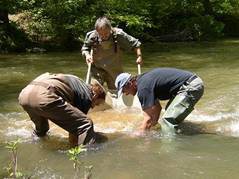

Overseeing the Water Resources of Loudoun County, VA
Stream Monitoring
Stream monitoring plays a critical role in water resource protection.
Monitoring is needed not only to provide baseline data, but also to assess
stream health and to resolve degradation problems. Stream monitoring is
particularly important in Loudoun County where existing baseline data has
already established that most streams do not meet water quality standards
and are impaired. Restoring the health of streams will require protecting
existing forested riparian buffer zones and installing best management
practices (BMPs) along degraded stream corridors. A comprehensive,
countywide monitoring program provides statistically valid baseline data
and measures the effectiveness of the needed BMPs..
- What are baseline conditions in each watershed? " Where are human impacts most affecting each watershed?
- Do the water quality, stream habitat, and biological conditions meet state aquatic life and recreation use requirements?

Stream monitoring training class
DEQ's Stream Monitoring Program -- In 2000 DEQ changed its stream monitoring program to include probabilistic monitoring of the state's waters, and to better respond to water quality problems found from monitoring data. The new DEQ strategy has substantial reduced DEQ's water quality monitoring activities in Loudoun County. For example, the number of monitoring stations has been reduced from 23 to 12, and the number of samples reduced from 174 in 1999 to 72 in 2001. At the same time, there is no state grant funding to support local citizen monitoring programs.
Local Citizen Stream Monitoring Programs -- The Loudoun Wildlife Conservancy (LWC) and the North Fork Goose Creek Watershed Committee are the principal citizen monitoring groups in Loudoun County. The Loudoun Soil and Water Conservation District (LSWCD) also monitors several streams.
Stream Monitoring and TMDL Implementation -- Stream monitoring is an important component of Total Maximum Daily Load (TMDL) Implementation Plans (IP). DEQ is supposed to provide stream monitoring data to validate the TMDL model and assess the effectiveness of the Implementation Plan. However, with DEQ's reduced monitoring frequency and stations, they are only able to provide a five-year rather than a yearly assessment of progress. The state has also declined to support local citizen monitoring to supplement DEQ monitoring. Without adequate monitoring to assess effectiveness, the validity of the IP is questionable.
info@loudounwatershedwatch.org Copyright © 2011 Loudoun Watershed Watch